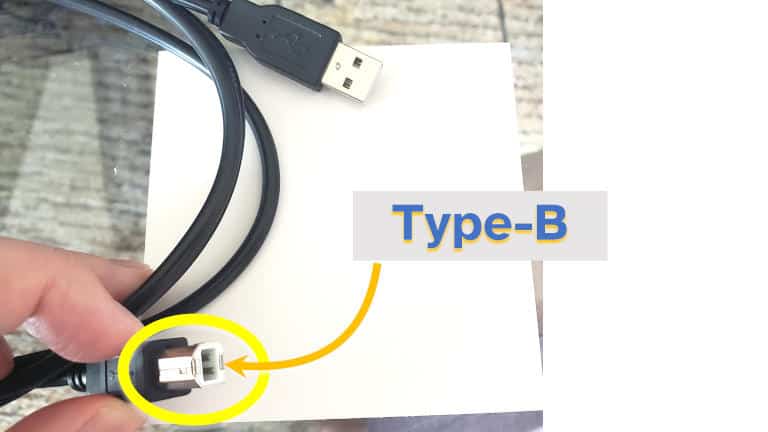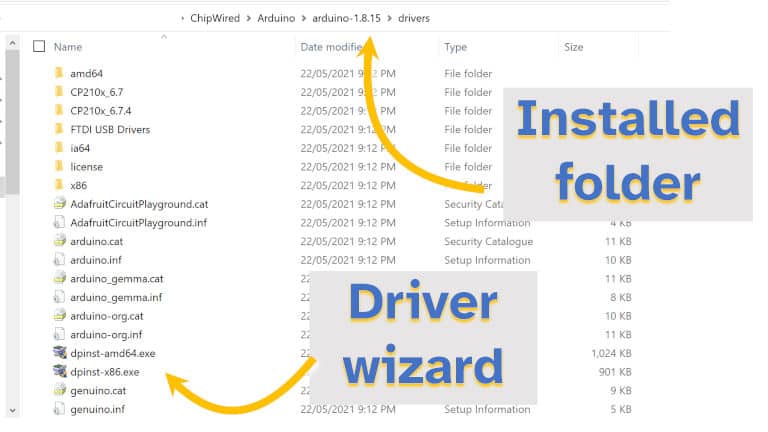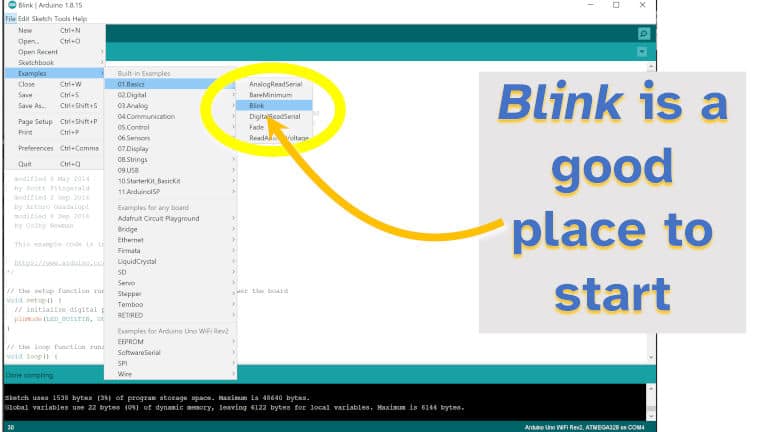Can See Device but Not When Uploading Arduino
As an electronics engineer getting back to my roots with Arduino, I constitute it could be a niggling confusing getting started uploading code (or sketches) to an Arduino. Installing drivers, IDEs, and everything else involved wasn't a straightforward task. And then I put this guide together based on my experience uploading lawmaking to a new Arduino on a new reckoner.
This guide is a stride-by-footstep (with pictures) on how to upload and run code on an Arduino using a Windows x car. The Arduino I've used is the UNO WiFi Rev 2, though the steps (and bug I solved) should be similar for almost Arduino models. See common problems at the lesser of this guide if you're having any bug following the steps. I've also tended to use sketch and lawmaking interchangeably in this guide, a symptom of being an electronics and software engineer by training.
Step one: Connect Arduino using a USB Cable
Typically a USB Type-B cable is used to connect to an Arduino – it has the USB ii.0 Blazon-B connector on i end and the USB 2.0 Blazon-A connector (for a reckoner on the other).

At the store, I asked for a "USB printer cable" as this is also the sort of cable that is used to connect a calculator to a printer. It cost me a few dollars. Any standard length seems to be OK, though I imagine information technology must be shorter than 5 metres (xvi feet); I ended up buying a 1m cable.
It didn't matter which USB socket I used on my calculator, they all seemed to work fine when communicating with the Arduino, even the USB Type-C hub that I use with my laptop allowed me to program the Arduino.
A separate ability cable is not required; the USB connectedness to the estimator volition power the board.
Demand more aid with which USB cable to apply, or which wires and cables an Arduino requires? I wrote a whole guide on USB cables and wires useful for Arduino, cheque it out here: chipwired.com/arduino-cables-and-wires
Footstep 2: Open the Arduino IDE
The IDE (Integrated Development Surroundings) is used to write code, compile programs, and upload them to the Arduino for it to execute.
The IDE can be downloaded from Arduino'south website hither. I used the portable ane, and then all I had to do was extract it to a folder and run the executable. If installing it, follow the steps in the installation wizard to go started – I believe the installation wizard has the advantage of taking intendance of installing the drivers for you. It's the IDE that lets yous write code into sketches, compile those sketches into instructions for the processor, and upload those instructions to the Arduino.
If using the portable IDE, you might need to install drivers (this is what I had to practice, run into "Issues I encountered" below). The easiest way I found to install drivers was to run the executable in the drivers folder where I extracted the executable to.

At beginning my lath wasn't listed, I had to click some text in the bottom left of the IDE to update it so that my board was shown. I was having a problem with uploading sketches until I clicked this update. Doing this update ran through the commuter install sorcerer as well (installing an additional driver), simply I imagine it's a good idea to run through the wizard separately anyway (equally I did higher up).
Footstep three: Select the Arduino Board and Port
Under the Tools carte at the top of the IDE, select your Board and your Port.

For Board, I establish that mine didn't evidence upwards at first, and the IDE had selected a similar model. This caused me problems afterward, then make sure your board is selected. If your board isn't listed, cheque out the previous steps about installing drivers.
For Port, I found that the IDE automatically selected the correct port as at that place was only i listed. Some of the enquiry I did said that if there was more i port, try each of them that's non COM1 (apparently Windows never allocates this to an Arduino).
If Port is greyed out it means that the IDE does not believe the Arduino is connected to the computer. Connect the Arduino and Port will become an option that tin exist selected. If the Arduino is continued, it means the IDE cannot identify it, have a look at installing the drivers every bit per Pace two.
Footstep 4: Prepare a Sketch (or write some code)
Starting with an example is the easiest way I've establish of testing out a new Arduino and computer setup, or getting started on your own project.
To use an example sketch, click File so Examples so Basics and I like to starting time with the glimmer case. This will load a new sketch that contains code to blink the LED on your board. These examples are already configured for your board and then it should glimmer the correct LED without whatever need to change the code.

Fifty-fifty when starting my own project, I like to utilise one of these examples as a starting point. It'south lawmaking and a setup that you know works, which is a expert place to start. I then add together to the code to accomplish whatever I'm trying to do.
Arduino code, independent in a sketch, is separated into ii sections: A setup, that's run once when the board powers up (or programming has finished); and a loop that runs in a loop as long as at that place is power to the lath. There are other means that code tin exist executed (I'm thinking interrupts here), but that's another article's worth of detail.
Footstep five: Upload Sketch (wait for the Tx and Rx LEDs flashing)
To get the lawmaking running on the Arduino, click Sketch then Upload. The upload step volition too practise the verify/compile step, and then at that place's no demand to click information technology separately for the purposes of this guide.
The RX and TX LEDs should flicker a piffling equally the IDE sends the code to the board.

I constitute that as before long as uploading the code was complete, the Arduino started to execute it. This took me a while to realise equally the default sketch loaded on my Arduino (UNO WiFi Rev 2) was the Blink one where the LED blinked every second. To test this, I modified the code to flash unevenly (try changing the delay(twenty) numbers) and then that information technology was obvious my code was running on the board.
If your code is not running on the board, check out the department below where I go through some of the issues I encountered.
Finishing Up
After following these steps, you should now accept:
- An Arduino connected to your estimator
- An IDE that uploads code/sketches from your computer to your Arduino
- An Arduino that executes the code that was uploaded to it

If you're Arduino is not running the uploaded code, there could exist a few things that went wrong. I've included below how I solved some of the problems I faced when uploading my commencement sketch to an Arduino.
Common Bug when Uploading Arduino Code
If you need help with writing the lawmaking for a sketch, I wrote a whole guide on the basics of an Arduino sketch and how to use variables, equations, loops, functions, and more. Cheque it out here: chipwired.com/arduino-programming-language-guide
These are the issues I found when I was trying to write my first program to an Arduino:
My Board Wasn't Listed in the IDE
Under the Tools menu you can encounter which board the IDE is intending to upload your program to. When I opened the IDE for the get-go fourth dimension, information technology automatically selected a board that was similar to mine merely not exactly the same. I encountered problems uploading the sketch to the board because I had the wrong one selected; my board wasn't even an choice!
To fix the problem where the target Arduino is not listed in the Tools menu:
- Install the latest drivers from Arduino, these tin be institute in the drivers folder where the arduino.exe file is stored
- Install whatsoever updates for the IDE, expect in the lesser left-hand corner when the IDE is get-go opened – information technology will alert you here if there are any necessary updates
Wrong COM Port or COM Port Greyed Out
Usually this is due to the incorrect drivers existence installed for the board you're using.
If you've installed all the drivers and your board is selected in the IDE (encounter above) simply the COM Port however isn't right, I've heard that updating the drivers in the Windows Device Manager is the manner to prepare this
Programmer is non responding
When I first tried to upload a sketch to my Arduino an error popped up maxim something similar avrguy: developer is not responding.
From my experience in microcontroller electronics (I'yard relatively new to Arduino), the Arduino that runs your code can be a separate board to the device that records the program to the Arduino (the 'programmer'). On my starting time Arduino (an UNO WiFi Rev two), the programmer and the microprocessor are role of the same board. Other Arduinos might have different configurations – eastward.thou. having a divide programmer tin can relieve space as it doesn't always need to be fastened.
To fix this problem:
- Ensure the correct board is selected in the Tools menu of the IDE
- If there is an option to select the Programmer (in the Tools menu), then brand sure the correct programmer is selected
- Ensure the correct drivers for your Arduino (and programmer if dissever) are installed on your calculator – see the steps above on how to practise this
Subsequently many years away from electronics projects, Chris recently dived back in past picking up an Arduino. This guide was written based on his first experiences setting upward a computer to program an Arduino.
Source: https://chipwired.com/uploading-code-arduino/
0 Response to "Can See Device but Not When Uploading Arduino"
Post a Comment